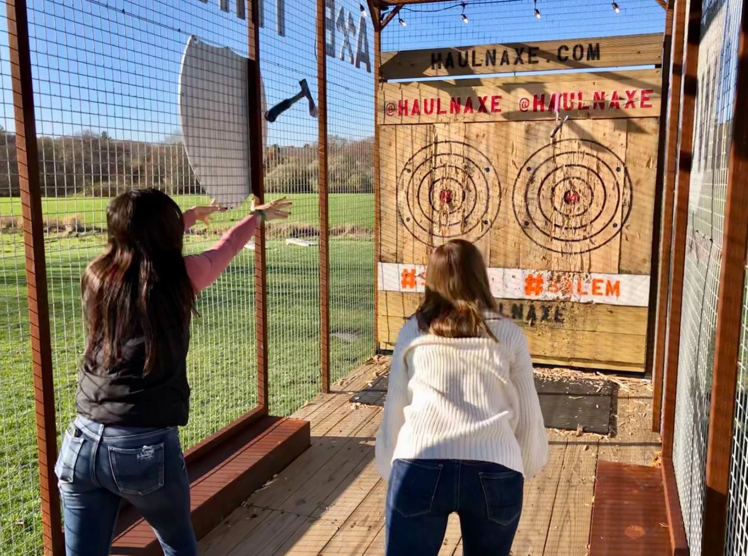Make Memories at Denver Axe Throwing: Tips for an Enjoyable Outing
Make Memories at Denver Axe Throwing: Tips for an Enjoyable Outing
Blog Article
The Enjoyable of Axe Throwing: How This Sporting Activity Incorporates Skill and Adrenaline for a Good Time
Axe throwing has arised as a captivating sporting activity that masterfully links the requirement for specific skill with the thrill of adrenaline, offering participants a unique and engaging experience. The act of tossing an axe towards a target requires focus and method, concurrently promoting an ambience of camaraderie and pleasant competition.
The Beginnings of Axe Throwing
Axe throwing, an entertainment activity that has gained substantial appeal in recent years, traces its origins back to ancient times. The earliest documents of axe use in competitive contexts are found among the Celts and Vikings, who tossed axes for sport as well as in battle training.
Middle ages European warriors, especially during the Middle Ages, practiced axe tossing as part of their martial training. The Francisca, a kind of tossing axe made use of by the Franks, became renowned for its deadly accuracy. This traditional weapon was made to be tossed at enemy guards and armor, showcasing its double utility in both sport and battle.
In more recent background, axe throwing saw a rebirth in the logging camps of North America in the 19th and 20th centuries. Lumberjacks would take part in friendly competitors, checking their precision and toughness by intending at wood targets. This evolution from a survival ability to a leisure task has led the way for its contemporary renewal, with dedicated locations and organizations now celebrating the sporting activity globally.
Devices You Need
Understanding the rich history of axe throwing boosts the admiration of the sport's modern iteration. Central to this thrilling activity is the devices, which is vital for both security and performance. The key tool is, obviously, the axe. For recreational and competitive axe throwing, one of the most frequently utilized type is the hatchet, normally considering in between 1.25 to 2 pounds with a handle size of about 16 inches. The axe should have a sharp, well-kept blade and a handle made from resilient wood or composite product, making sure a great grip and equilibrium.
Just as crucial is the target. Regulation targets are created from wood, with softwood ranges like pine or cottonwood being favored for their capacity to take in and hold the axe. The target is typically split into 5 concentric circles, each with a details point value, to facilitate rating.
Safety and security equipment, though often forgotten, is essential. Protective handwear covers can boost grip and stop sores, while closed-toed shoes are a must to safeguard feet from dropped axes (axe throwing denver colorado). Ultimately, a well-lit, large throwing area, full with security obstacles, makes sure a regulated atmosphere where individuals can focus on refining their skills.
Fundamental Techniques Discussed
Grasping the fundamental techniques of axe throwing is crucial for both safety and security and effectiveness. The leading hand must be positioned directly below the axe head, while the non-dominant hand sustains the end of the manage.
Your leading foot ought to be slightly forward, straightening with your target. This positioning aids in maintaining stability and guiding power Source precisely towards the target.

Security First
Guaranteeing safety and security in axe throwing is critical to developing a enjoyable and injury-free experience. A properly designed axe throwing facility features clear next page separations in between throwing lanes, durable backdrops to catch roaming axes, and non-slip floor covering to protect against accidents.
Benefits of Axe Throwing
Axe tossing offers a myriad of advantages that extend beyond basic recreation. Physically, it provides a full-body exercise, engaging muscle mass in the arms, shoulders, back, and core. The repeated motion of tossing the axe likewise improves hand-eye sychronisation and fine electric motor abilities. For those looking to enhance their general physical fitness, axe throwing can function as a interesting and dynamic kind of workout.
Mentally, axe tossing needs emphasis, approach, and accuracy, making it a superb method to develop cognitive skills. The concentration needed to hit the target can act as a form of mindfulness, allowing individuals to clear their minds and lower tension. This psychological involvement can be specifically helpful in helping individuals create better analytic skills and psychological strength.
Socially, axe throwing is usually appreciated in group settings, fostering team-building and friendship. Whether as component of a business occasion or a casual getaway with buddies, the sport encourages communication and partnership. In addition, the common experience of learning and improving with each other can enhance relationships and create long lasting memories.
Verdict

The earliest documents of axe use in competitive contexts are discovered among the Celts and Vikings, that threw axes for sporting activity as well as in battle training. Launch the axe when your hands are about at eye degree, permitting the axe's all-natural turning to direct it towards the target.
A properly designed axe tossing facility attributes clear separations in between tossing lanes, strong backdrops to capture stray axes, and non-slip flooring to avoid crashes. Participants must be advised on the correct way to deal with and throw the axe, highlighting controlled, intentional activities over forceful throws.
In recap, axe tossing stands out as a sporting activity that masterfully incorporates ability, adrenaline, and accuracy.
Report this page